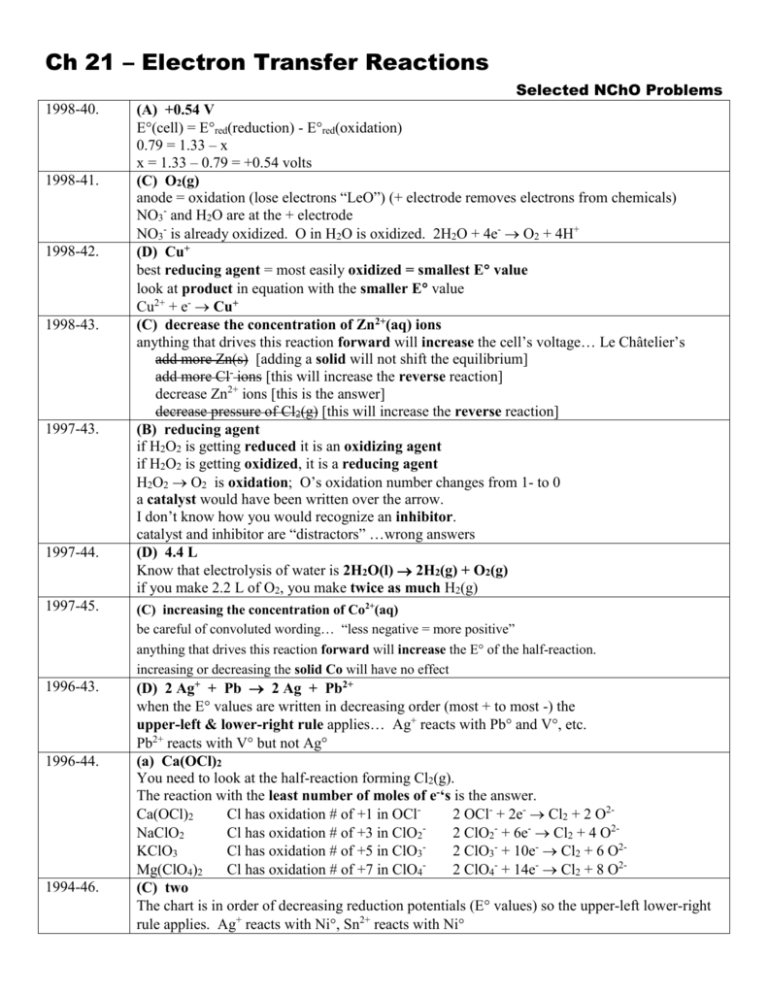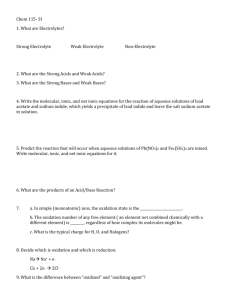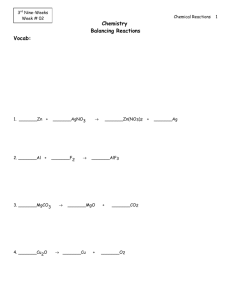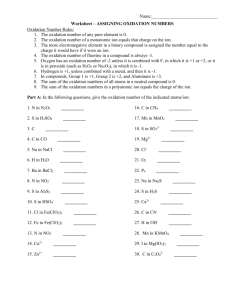Ch 19 – Solubility Equilibria
advertisement

Ch 21 – Electron Transfer Reactions 1998-40. 1998-41. 1998-42. 1998-43. 1997-43. 1997-44. Selected NChO Problems (A) +0.54 V E(cell) = Ered(reduction) - Ered(oxidation) 0.79 = 1.33 – x x = 1.33 – 0.79 = +0.54 volts (C) O2(g) anode = oxidation (lose electrons “LeO”) (+ electrode removes electrons from chemicals) NO3- and H2O are at the + electrode NO3- is already oxidized. O in H2O is oxidized. 2H2O + 4e- O2 + 4H+ (D) Cu+ best reducing agent = most easily oxidized = smallest E value look at product in equation with the smaller E value Cu2+ + e- Cu+ (C) decrease the concentration of Zn2+(aq) ions anything that drives this reaction forward will increase the cell’s voltage… Le Châtelier’s add more Zn(s) [adding a solid will not shift the equilibrium] add more Cl- ions [this will increase the reverse reaction] decrease Zn2+ ions [this is the answer] decrease pressure of Cl2(g) [this will increase the reverse reaction] (B) reducing agent if H2O2 is getting reduced it is an oxidizing agent if H2O2 is getting oxidized, it is a reducing agent H2O2 O2 is oxidation; O’s oxidation number changes from 1- to 0 a catalyst would have been written over the arrow. I don’t know how you would recognize an inhibitor. catalyst and inhibitor are “distractors” …wrong answers (D) 4.4 L Know that electrolysis of water is 2H2O(l) 2H2(g) + O2(g) if you make 2.2 L of O2, you make twice as much H2(g) 1997-45. (C) increasing the concentration of Co2+(aq) be careful of convoluted wording… “less negative = more positive” anything that drives this reaction forward will increase the E of the half-reaction. increasing or decreasing the solid Co will have no effect 1996-43. (D) 2 Ag+ + Pb 2 Ag + Pb2+ when the E values are written in decreasing order (most + to most -) the upper-left & lower-right rule applies… Ag+ reacts with Pb and V, etc. Pb2+ reacts with V but not Ag (a) Ca(OCl)2 You need to look at the half-reaction forming Cl2(g). The reaction with the least number of moles of e-‘s is the answer. Ca(OCl)2 Cl has oxidation # of +1 in OCl2 OCl- + 2e- Cl2 + 2 O2NaClO2 Cl has oxidation # of +3 in ClO2 2 ClO2- + 6e- Cl2 + 4 O2KClO3 Cl has oxidation # of +5 in ClO32 ClO3- + 10e- Cl2 + 6 O2Mg(ClO4)2 Cl has oxidation # of +7 in ClO42 ClO4- + 14e- Cl2 + 8 O2(C) two The chart is in order of decreasing reduction potentials (E values) so the upper-left lower-right rule applies. Ag+ reacts with Ni, Sn2+ reacts with Ni 1996-44. 1994-46. 1994-48. 1993-67. 1993-66. 1992-59. 1992-60. (D) Ti4+ You need to visualize the half-reactions for each metal. The reaction with the most electrons involved will require the greatest length of time. Ag+ + e- Ag Cu2+ + 2e- Cu Fe3+ + 3e- Fe Ti4+ + 4e- Ti (C) 20 This is a line equation. Remember to begin with “amps x time” 60 sec 1 Couloumb 1 mole e - 1 mole Co 58.93 g Co 10 amps 109 min 19.969 g Co 1 min 1 amp sec 96,500 C 2 mole e - 1 mole Co (B) 1.55 V E(cell) = Ered(reduction) - Ered(oxidation) = -0.13 volts –(-1.68 volts) = +1.55 volts Note: The overall reaction is 3Pb2+ + 2Al 3Pb + 2Al3+ (6 moles of electrons are involved) but the coefficients of 2 and 3 are not used for this calculation… not like Hess’s Law. (A) 0.255 g This is a line equation. Remember to begin with “amps x time” 60 sec 1 Couloumb 1 mole e - 1 mole Ag 107.9 g Ag 2 amps 1.9 min 0.2549 g Ag 1 min 1 amp sec 96,500 C 1 mole e - 1 mole Ag (C) 0.492 V IF this were a STANDARD cell (everything 1 M) the equation would be: E(cell) = Ered(reduction) - Ered(oxidation) -0.250 volts – (-.763 volts) = +0.513 volts (answer D) However… The shortcut cell notation (anode || cathode) shows that the [Zn2+] is only 0.5 M. The overall reaction is: Zn2+ + Ni Zn + Ni2+ Since [Zn2+] is reduced, the cell will run at a little lower voltage… best answer is 0.492 volts. You can also calculate this answer using the Nernst equation.







